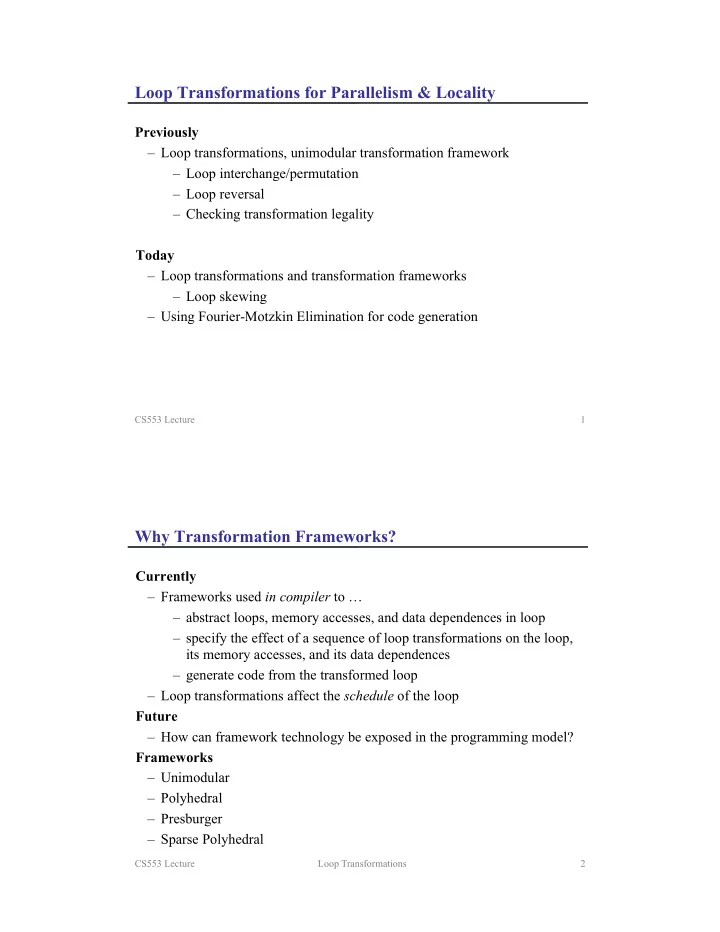

Loop Transformations for Parallelism & Locality Previously – � Loop transformations, unimodular transformation framework – � Loop interchange/permutation – � Loop reversal – � Checking transformation legality � Today – � Loop transformations and transformation frameworks – � Loop skewing – � Using Fourier-Motzkin Elimination for code generation CS553 Lecture 1 Why Transformation Frameworks? � Currently – � Frameworks used in compiler to … – � abstract loops, memory accesses, and data dependences in loop – � specify the effect of a sequence of loop transformations on the loop, its memory accesses, and its data dependences – � generate code from the transformed loop – � Loop transformations affect the schedule of the loop � Future – � How can framework technology be exposed in the programming model? � Frameworks – � Unimodular – � Polyhedral – � Presburger – � Sparse Polyhedral CS553 Lecture Loop Transformations 2
Frameworks for Loop Transformations � Unimodular Loop Transformations [Banerjee 90],[Wolf & Lam 91] – � can represent loop permutation, loop reversal, and loop skewing – � unimodular linear mapping (determinant of matrix is + or - 1) – � T i = i’, T is a matrix, i and i’ are iteration vectors – � transformation is legal if the transformed dependence vector remain lexicographically positive – � limitations – � only perfectly nested loops – � all statements are transformed the same CS553 Lecture 3 Loop Skewing Original code � do i = 1,6 do j = 1,5 � j A(i,j) = A(i-1,j+1)+1 i � enddo � � enddo (1, -1) � Distance vector: � Can we permute the original loop? � Skewing: j’ i’ CS553 Lecture 4
Transforming the Dependences and Array Accesses Original code � do i = 1,6 do j = 1,5 � A(i,j) = A(i-1,j+1)+1 � j enddo � i � enddo � Dependence vector: � New Array Accesses: j’ i’ CS553 Lecture 5 Transforming the Loop Bounds Original code � do i = 1,6 do j = 1,5 � A(i,j) = A(i-1,j+1)+1 � j enddo � � enddo i � Bounds: Transformed code � do i’ = 1,6 do j’ = 1+i’,5+i’ j’ � A(i’,j’-i’) = A(i’-1,j’-i’+1)+1 � enddo � � enddo i’ CS553 Lecture 6
Code Generation � Goals – � express outermost loop bounds in terms of symbolic constants and constants – � express inner loop bounds in terms of any enclosing loop variables, symbolic constants, and constants � Approach – � Project out inner loop iteration variables to determine loop bounds for outer loops – � Fourier Motzkin elimination is the algorithm that projects a variable out of a polyhedron CS553 Lecture 7 Fourier-Motzkin Elimination: The Idea 1 >= i � Polyhedron – � convex intersection of a set of j <=5 inequalities – � model for iteration spaces i <= j j � Problem – � given a polyhedron how do we generate loop bounds that i scan all of its points? – � example: two possible loop orders – � ( i , j ) – � ( j , i ) CS553 Lecture 8
Fourier-Motzkin Elimination: The Algorithm � FM( P, i_k ) => P’ Input: Output: Algorithm: for each lower bound of for each upper bound of CS553 Lecture 9 Distinguishing Upper and Lower Bounds � Simple Algorithm – � given that the polyhedron is represented as follows: – � any constraint with a positive coefficient for i_k is a lower bound – � any constraint with a negative coefficient for i_k is an upper bound j <=5 i <= j j CS553 Lecture 10 1 >= i i
Triangular Iteration Space Example � ( i, j ) for target iteration space j <=5 i <= j j i � ( j, i ) for target iteration space 1 >= i CS553 Lecture 11 General Algorithm for Generating Loop Bounds Input: where the i vector is the desired loop order Output: Algorithm: for k = d to 1 by -1 CS553 Lecture 12
Loop Skewing and Permutation Original code � do i = 1,6 do j = 1,5 � j A(i,j) = A(i-1,j+1)+1 i � enddo � � enddo (1, -1) � Distance vector: � Skewing followed by Permutation: i’ j’ CS553 Lecture 13 Transforming the Dependences and Array Accesses Original code do i = 1,6 � do j = 1,5 � A(i,j) = A(i-1,j+1)+1 � j enddo � i enddo � � Dependence vector: � New Array Accesses: i’ j’ CS553 Lecture 14
Transforming the Loop Bounds Original code � do i = 1,6 do j = 1,5 � A(i,j) = A(i-1,j+1)+1 � j enddo � � enddo i � Bounds: Transformed code (use general loop bound alg) � do i’ = 2,11 do j’ = max(i’-5,1), min(6,i’-1) � i’ A(j’,i’-j’) = A(j’-1,i’-j’+1)+1 � enddo � � enddo j’ CS553 Lecture 15 Wavefront Parallelism Example � Example � do i = 1,6 do j = 1,min(5,7-i) � A(i,j) = A(i-1,j-1) � � + A(i,j-1) j enddo � � enddo i Iteration Space � Goal – � Determine a unimodular transformation that enables indicating that the inner loop is fully parallel. (with an OpenMP directive for example) � do i’ = 1,5 do j’ = 1, 7-i’ (parallel) � A(j’,i’) = A(j’-1,i’-1) � + A(j’,i’-1) enddo � enddo CS553 Lecture 16
Concepts � Unimodular transformation framework – � represents loop permutation, loop reversal, and loop skewing – � provides mathematical framework for ... – � testing transformation legality, – � transforming array accesses and loop bounds, – � and combining transformations Fourier-Motzkin Elimination – � algorithm – � using for code generation Loop bounds – � how to determine upper and lower bounds for a variable when bounds are in matrix format � Examples – � triangular matrix, skew and permute example, and wavefront example CS553 Lecture 17 Next Time � Lecture – � More loop transformations – � Another transformation framework � CS553 Lecture Loop Transformations 18
Recommend
More recommend